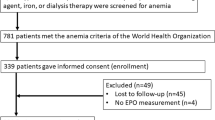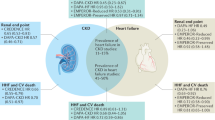Abstract
Anaemia is an independent predictor of adverse outcomes in chronic kidney disease (CKD). Randomized trials using erythropoiesis-stimulating agents (ESAs) in patients with severe anaemia (baseline haemoglobin level <100 g/l) have been small, and the hypothesis that partial correction of severe anaemia may prevent cardiovascular events is tenable but unproven. Results from randomized trials of moderate anaemia correction with ESAs do not support the hypothesis that moderate anaemia is a cardiovascular risk factor. This Perspectives article discusses the idea that this finding may have been a result of the inadequate design of trials, co-intervention with high doses of ESAs or intravenous iron hiding a beneficial effect. Another idea is also discussed—that moderate anaemia is a marker of the degree of renal impairment and that its association with cardiovascular disease merely signifies that other factors are present that are pathogenic to the heart and associated with both kidney impairment and anaemia.
This is a preview of subscription content, access via your institution
Access options
Subscribe to this journal
Receive 12 print issues and online access
$209.00 per year
only $17.42 per issue
Buy this article
- Purchase on Springer Link
- Instant access to full article PDF
Prices may be subject to local taxes which are calculated during checkout
Similar content being viewed by others
References
Shamseddin, M. K. & Parfrey, P. S. Mechanisms of the cardiorenal syndromes. Nat. Rev. Nephrol. 5, 641–649 (2009).
Foley, R. N. et al. The impact of anemia on cardiomyopathy, morbidity, and mortality in end-stage renal disease. Am. J. Kidney Dis. 28, 53–61 (1996).
Ofsthun, N., Labrecque, J., Lacson, E., Keen, M. & Lazarus, J. M. The effects of higher hemoglobin levels on mortality and hospitalization in hemodialysis patients. Kidney Int. 63, 1908–1914 (2003).
Regidor, D. L. et al. Associations between changes in hemoglobin and administered erythropoiesis-stimulating agent and survival in hemodialysis patients. J. Am. Soc. Nephrol. 16, 1181–1191 (2006).
Rigatto, C. et al. Congestive heart failure in renal transplant recipients: risk factors, outcomes, and relationship with ischemic heart disease. J. Am. Soc. Nephrol. 13, 1084–1090 (2002).
Rigatto, C. et al. Electrocardiographic left ventricular hypertrophy in renal transplant recipients: prognostic valve and impact of blood pressure and anemia. J. Am. Soc. Nephrol. 14, 462–468 (2003).
Besarab, A. et al. The effects of normal as compared with low hematocrit values in patients with cardiac disease who are receiving hemodialysis and epoetin. N. Engl. J. Med. 339, 584–590 (1998).
Parfrey, P. S. et al. Double-blind comparison of full and partial anemia correction in incident hemodialysis patients without symptomatic heart disease. J. Am. Soc. Nephrol. 16, 2180–2189 (2005).
Drüeke, T. B. et al. Normalization of hemoglobin level in patients with chronic kidney disease and anemia. N. Engl. J. Med. 355, 2071–2084 (2006).
Singh, A. K. et al. Correction of anemia with epoetin alfa in chronic kidney disease. N. Engl. J. Med. 355, 2085–2098 (2006).
Pfeffer, M. A. et al. A trial of darbepoetin alfa in type 2 diabetes and chronic kidney disease. N. Engl. J. Med. 361, 2019–2032 (2009).
Parfrey, P. S., Lauve, M., Latremonille-Vian, D. & Lefebvre, P. Erythropoietin therapy and left ventricular mass index in CKD and ESRD patients: a meta-analysis. Clin. J. Am. Soc. Nephrol. 4, 755–762 (2009).
Kidney Disease: Improving Global outcomes (KDIGO) Anemia Work Group. KDIGO clinical practice guideline for anemia in chronic kidney disease. Kidney Int. Suppl. 2, 279–335 (2012).
Foley, R. N., Curtis, B. M., Randell, E. W. & Parfrey, P. S. Left ventricular hypertrophy in new hemodialysis patients without symptomatic cardiac disease. Clin. J. Am. Soc. Nephrol. 5, 805–813 (2010).
Eckardt, K. U. et al. Left ventricular geometry predicts cardiovascular outcome associated with anemia correction in CKD. J. Am. Soc. Nephrol. 20, 2651–2660 (2009).
Solomon, S. D. et al. Erythropoietic response and outcomes in kidney disease and type 2 diabetes. N. Engl. J. Med. 363, 1146–1155 (2010).
Author information
Authors and Affiliations
Ethics declarations
Competing interests
P. S. Parfrey declares an association with Amgen (consultant, sponsored to give invited talks at hospitals).
Rights and permissions
About this article
Cite this article
Parfrey, P. Why does the treatment of anaemia not improve cardiac outcomes in CKD?. Nat Rev Nephrol 9, 59–61 (2013). https://doi.org/10.1038/nrneph.2012.239
Published:
Issue Date:
DOI: https://doi.org/10.1038/nrneph.2012.239



